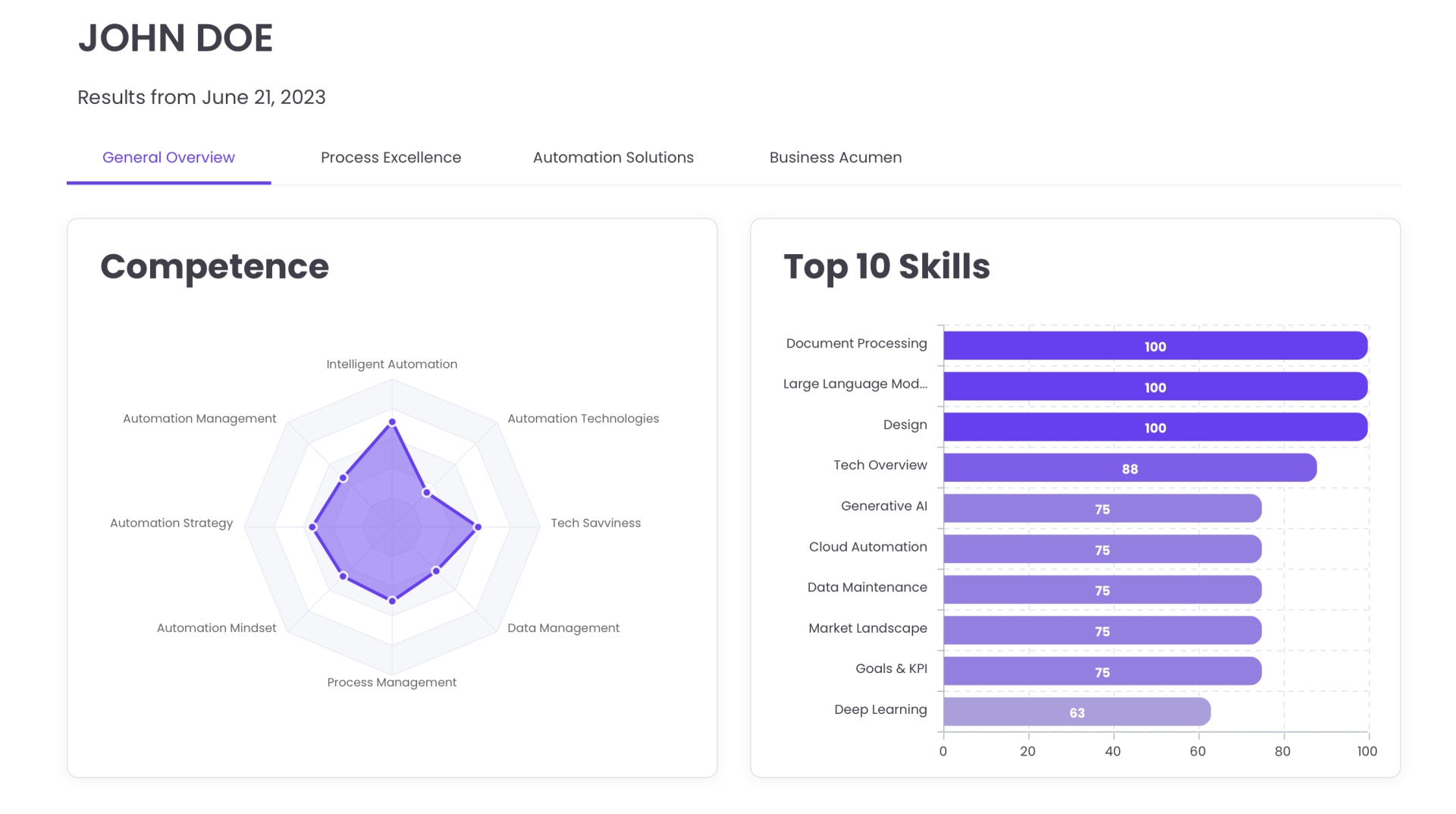In today's whirlwinding digital landscape, upskilling isn’t just a buzzword – it's a necessity. It’s not only about improving workforce productivity, but really about supporting your organization in its quest towards the north star.
But amidst the buzz, how can you tell what skills your employees really need? Enter the skill gap analysis – an unsung hero that helps you unlock your talent’s full potential.
This tool is your secret weapon for effective upskilling. In this article, we look at why it’s such a game changer and how to use it to prepare your teams for the future of work.
Bonus: read till the end to discover our example of a skill assessment tool that you can use today to analyze your talent’s fluency in digital technologies and business process automation.
Pros and Cons of a Skill Gap Analysis
You’d be tempted to think that performing a skill gap analysis only has benefits. But there are certain circumstances when it may not be appropriate or affordable to do this. On top of that, you should keep an eye out for how it may impact certain groups of people – especially those that are being evaluated.
Pros:
- Targeted Training: Knowing the gaps helps you create focused training programs.
- Resource Allocation: You can allocate resources more efficiently when you know where the gaps are.
- Employee Satisfaction: Employees appreciate when their training is relevant and impactful.
Cons:
- Time and Cost: A thorough analysis can be labor-intensive. Plus, employees must stop what they’re doing which can impact their productivity. Expect this process to take longer the bigger your company is.
- Dynamic Nature of IT: The fast-paced evolution of technology can quickly make your analysis outdated. This also means that you must devise ways of checking-in and refreshing your information on a regular basis.
- Buzzkill: The results can impact how employees see themselves. Encourage them to take this as an opportunity to grow and to focus on the positive!
How Do You Perform a Skill Gap Analysis?
Conducting a skill gap analysis seems pretty straightforward, yet as an HR manager in large enterprises you can struggle to draw conclusions to support your strategy, simply because of the sheer volume of data. What’s more, each department has its own unique skill needs and this calls for a differentiated approach in your analysis of training needs.
Bonus: Check out our HR Digitization and Automation Playbook
Keep in mind that reviewing your workforce’s skills is not a one-time event but an ongoing process. Use a combination of employee skill assessment surveys, interviews, and real-world evaluations to get a comprehensive view.
In a nutshell, these are the steps you need to take when conducting an employee skill gap analysis.
- Assess the Company Objectives: It’s important to link your analysis to the overall company goals to make sure that you are addressing pressing needs.
- Identify Key Skills: List the essential skills required for each role.
- Assess Current Skills: Use assessments or surveys to gauge the current skill levels of your employees.
- Analyze the Gap: Compare the required skills against the current skills to identify the gaps.
- Prioritize Your Insights: Use the gathered information to define which areas you will focus on in order to gain a competitive advantage.
Example Employee Skills Assessment Questionnaire
To help you with step 3 of this process, we would like to share our own version of a skill assessment.
If you’re looking for a way to evaluate digital fluency and automation skills, you’ve just hit the jackpot! And if you’re interested in assessing some other IT skills, why not take a look at our survey as an example for building your own? It’s free to test and it only takes 15 minutes.
What is the Bots & People Skill Assessment?
Enabling meaningful work for everyone is our credo, and Business Process Automation (BPA) is our bread and butter. This is why our learning experts have devised a simple yet powerful method for assessing digital fluency skills in this area.
The Bots & People Skill Assessment is a self-analysis tool based on a model comprising eight competencies essential for BPA proficiency. These competencies are categorized into three distinct domains, namely Business Acumen, Process Excellence, and Automation Solutions.

Regardless of the current skill level, this self-assessment gives learners a clear and precise reflection of their strengths, helping them define the next milestone in the journey to developing digital fluency in automation.
Upon completion, learners receive an exhaustive report outlining the highest and lowest proficiency levels across the competencies. Detailed explanations accompany each competency, offering insights into strengths and areas in need of further development.
Pro tip: Leverage these insights to craft targeted learning objectives, a strategic compass to navigate the dynamic landscape of the evolving market. In essence, this self-assessment is not just a tool; it's a roadmap to BPA excellence.
>>> Click here to take the quiz
We are constantly updating the tool to deliver a stellar learning experience and support dedicated learning leaders like you to empower their teams for meaningful work. Our upcoming skill-assessment features include:
- Comparison to desired competency profiles
- Progress tracking
- Further assessments for specific technologies
- Group assessments for team-level insights
For a limited time, we are offering custom team-level assessments for companies looking to advance their talent’s competencies in Business Process Automation. To apply for a personalized assessment, send us a message using the contact page and we’ll get in touch with you to discuss your needs.
You may also be wondering…
What is the IT Skills Gap?
The IT skills gap is the discrepancy between the skills your workforce currently possesses and the skills they need to achieve your organization’s ambitions. It's not just about coding; it's about digital literacy as a whole. This includes understanding data analytics, cybersecurity, cloud computing, and yes, even automation and artificial intelligence.
The 3 Biggest Technology Skill Gaps
According to Statista, these are the top 3 skill gaps that organizations struggle with in 2023:
- IT Technicians: Perhaps unsurprisingly, the need for tech talent is advancing faster than the pace at which qualified workers become available. A possible solution to this bottleneck is offered by emerging low-code/no-code technologies
- Cloud computing: The flexibility afforded by cloud computing means that more companies are adopting it for their operations, and are therefore in need of skilled professionals to implement it.
- Artificial Intelligence and Automation: With AI becoming ubiquitous, the shortage of skilled professionals in this area is palpable. To help bridge the gap, Bots & People offers dedicated courses that help enterprises initiate their workforce in these fields.
This is just the top of the iceberg and there are many more areas affected by a shortage of skills. A study by the World Economic Forum found that six in 10 workers will require training before 2027, but only half of workers are seen to have access to adequate training opportunities today.
Why Is There a Technology Skills Gap?
The technology skills gap exists primarily because of the rapid advancements in technology outpacing the rate at which employees can learn these new skills.
Digital transformation strategies often move forward with tool implementation without considering the need to train employees in how to use the new tech. That sadly leaves people in a rut and struggling to adapt to new processes and ways of working.
Why Is There a Shortage of AI Talent?
AI is a specialized field that requires a unique set of skills, including data science, machine learning algorithms, and ethical considerations. The demand for these skills far outstrips the current supply and this is why there is a growing shortage of AI talent.
What Skills Are We Losing With Technology?
While technology brings many advantages, there's a concern that we're losing essential soft skills like communication, critical thinking, and emotional intelligence. Balancing technological prowess with these human skills is crucial. In fact, according to a report by the World Economic Forum, the top three skills that employers are looking for in 2023 are creative thinking, analytical thinking, and a combination of resilience, flexibility, and agility.
Final Thoughts
In conclusion, a skill gap analysis is not just a diagnostic tool; it's a strategic instrument for organizational growth. So, if you're serious about upskilling your workforce, start with a skill gap analysis, such as the. The insights you gain will be the cornerstone of an effective and impactful training program.









